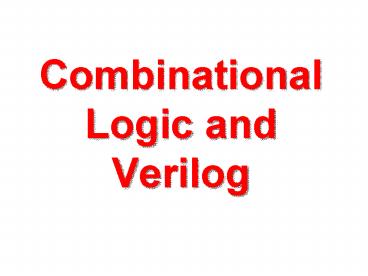Combinational Logic and Verilog PowerPoint PPT Presentation
Title: Combinational Logic and Verilog
1
Combinational Logic and Verilog
2
- Programmable Array Logic
- PAL
3
Example of PAL. GAL16V8C
4
PALs
- SOP
- Multi-level
- Flip-flops
- 10 Inputs
- 8 Inputs/output
Figure 6-26. PAL16L8
5
Figure 6-28. General CPLD architecture
Complex PLD
6
43 PLA in CMOS logic
7
EEPLDs
- Floating gate
- Non-floating gate
AND plane of EEPLD using floating-gate MOS
transistors
8
- Decoders
9
General Structure of a Decoder circuit
10
Example 1 Truth table for a 2-to-4 binary
decoder.
Example of a decoder circuit
enable
11
2-to-4 decoder inside
enable
12
Verilog for 2-to-4 decoder
Structural type of description in Verilog
13
Example 2 Position encoding for a 3-bit
mechanical encoding disk
14
Example 2 continued Using a 3-to-8 decoder to
decode a Gray code.
15
Example 3 74x138 3-to-8 decoder
16
Example 3 74x138 3-to-8 decoder
17
Example 3 cont 74X138 3-to-8 decoder
18
Verilog code for 3-to-8 decoder
15..7
19
Verilog for 3-to-8 decoder
Y_L0 Y_L1 Y_L2 Y_L3 Y_L4 Y_L5 Y_L7
A2 A1 A0
20
74X138 Decoder Active level handling
21
74x138 like decoder with Active level handling
22
Active high 3-to-8 decoder
23
Behavioral Verilog for 3-to-8 decoder
24
Example 3 cont 74x138 3-to-8 decoder
Default signal names
25
Example 3 cont Symbols for 74x138
Incorrect because of double negations
26
Example 3 cont 5-to-32 decoder from 74X138 chips
Chip select goes to input G2B
Global enable goes to inputs G1 and G2A
27
Example 3 cont 4-to-16 decoder using 74X138
N3
28
Example 3 cont 74x138 decoder using GAL
74x138 decoder can be built in single GAL 16V8
chip
29
Figure 6-41. 74x138-like decoder
30
Example Customized decoder function
31
Customized decoder circuit Using 74X138
32
- Seven Segment Display and Decoder
33
Seven Segment Display
34
Seven Segment Decoder
35
Encoders
We already used encoders to design control logic
for data path blocks
36
Encoders
2n requests
37
- Priority Encoders
38
Encoders
Number n of prioritized request
Any subset if 2n requests
39
Encoders
40
8-input Priority Encoder
enable
41
15-input Priority Encoder in PLD
outputs
inputs
42
Priority Encoder handle 32 requests
43
8-input Priority Encoder
44
- Three state
- Buffers
45
Various three-state buffers
46
Use of three-state buffers
Eight sources sharing a three-state party line
47
Timing diagram for the three-state party line
48
74x541 Octal three-state buffer
49
- Three-State buffers in microprocessors
50
74x541 as a microprocessor input port.
51
Verilog module for a 74x540-like 8-bit
three-state driver
52
74x245 octal three-state transceiver
53
Verilog module for a 74x245-like 8-bit transceiver
54
Bidirectional buses and transceiver operation
55
Bus selection codes for a four-way bus transceiver
56
PLD inputs and outputs for a four-way, 2-bit bus
transceiver
57
Verilog module for a four-way, 2-bit bus
transceiver
58
- Multiplexers
59
Multiplexer structure
60
74x151 8-input, 1-bit mux
61
74x151 8-input, 1-bit mux
62
Combining 74x151s to make a 32-to-1 multiplexer
Decoding and enabling
63
74x157 2-input 4-bit mux
64
GAL16V8 used as a 74x157 multiplexer
2 inputs, each 4 bits
65
Buffers to handle large fanout
66
A mux driving a bus and a demux receiving the bus
67
- Decoders as demultiplexers
68
3-to-8 binary decoder as a demultiplexer
69
- GALs as multiplexers
70
Function table for a SPECIALIZED 4-input, 18-bit
mux.
71
Behavioral Verilog for a specialized 4-input
18-bit mux
72
Dataflow Verilog for a 4-input, 8-bit mux
73
Behavioral Verilog for a 4-input, 8-bit mux.

